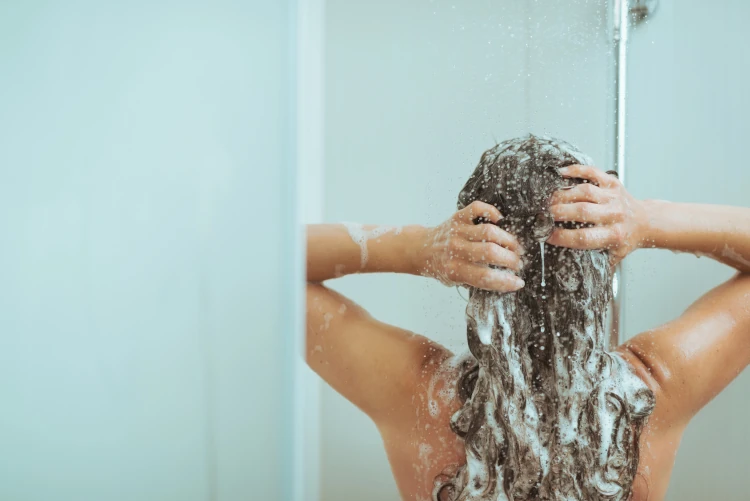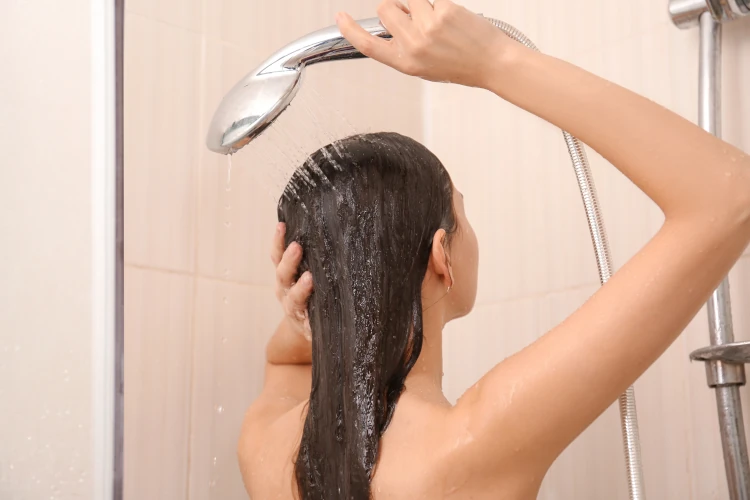
How Much Hair Is Normal To Lose in the Shower?
Daily hair shedding is a completely natural part of your hair’s growth cycle, and losing strands during washing happens to everyone. Your scalp releases hair (typically 50 to 100 strands a day) that has completed its growth phase, making the shower an ideal time for this process to occur. You notice more hair falling out during washing because water and manipulation dislodge strands that were already preparing to shed.
However, you may worry when clumps of hair circle the shower drain, especially after shampooing or conditioning. Much of what looks alarming may still fall within normal daily hair loss ranges. What seems excessive could actually be several days’ worth of natural shedding happening at once. That’s why it’s important to get a better idea of what normal hair loss looks like.
Understanding Normal Hair Loss in the Shower
Washing significantly increases visible hair loss because water and friction naturally dislodge strands that are already in the shedding phase of their growth cycle. Combining wet hair, shampooing motions, and conditioning creates optimal conditions for loose strands to separate from your scalp. This process concentrates what would otherwise occur gradually throughout multiple days.
Your hair’s density, length, and washing schedule influence how much accumulates in the drain. If you have abundant, lengthy hair, you’ll often notice more strands simply because each fallen piece creates a greater visual impact. Washing frequency dramatically affects observations — daily cleansers typically encounter fewer strands per session compared to those who shampoo twice weekly.
For those worried about visible thinning, hair loss follows predictable stages. Diffuse shedding in the shower does not follow the temple-to-crown pattern typical of androgenic alopecia (AGA).
When Hair Falling Out in the Shower Might Be a Problem

There are some clear signs that your hair loss in the shower might fall outside of the normal range.
Pay attention when sudden increases in shedding occur, visible patches appear on your scalp, or your part line widens noticeably. These changes often develop gradually, which makes them challenging to detect until they become more pronounced. If your usual hair loss during showers doubles or triples without explanation, it warrants attention, especially if this change persists for several weeks.
Changes like telogen effluvium (TE) and traction alopecia trigger excessive hair loss that becomes noticeable during washing. TE often results from stress, dramatic diet changes, illness, or hormonal fluctuations like postpartum changes. It usually appears two to three months after the inciting event, lasting more than six months in acute cases. Traction alopecia develops from consistently tight hairstyles that pull on hair follicles, weakening them over time until they can no longer support healthy growth.
Chronic scalp inflammation contributes significantly to accelerated hair loss, particularly when left untreated or undiagnosed for months or years. Chronic inflammatory disorders, such as lichen planopilaris or folliculitis decalvans, can scar follicles permanently, but routine TE does not cause scarring. Recognizing and addressing scalp inflammation early prevents irreversible damage beyond what you’ll notice in your shower drain.
Preventing Unnecessary Hair Loss While Washing
Brushing your hair before showering removes strands that are already loose, minimizing dramatic accumulation during cleansing and reducing visual shock. Normal shower temperatures have minimal impact on keratin strength, but avoid using very hot styling tools once you’re finished (more than 280 degrees Fahrenheit). While washing, massage your scalp with your fingertips to generate adequate cleansing action without the harsh scraping that fingernails create.
If you have a sensitive scalp, a mild (ideally sulfate-free) shampoo can reduce irritation, though it has no proven effect on hair-loss rate. Select formulations designed for your specific hair texture, whether fine, coarse, curly, or chemically processed, to optimize results without over-stripping natural oils. Match your product selection to your needs to prevent unnecessary chemical stress on vulnerable strands.
Your washing technique adjustments build up over time to strengthen overall hair resilience and reduce mechanical damage. Handle your hair gently during vulnerable wet states to protect existing strands from premature breakage. If you can work these protective habits into your hair care routine consistently, you may start to see noticeable improvements within a few months.
What To Do If You’re Concerned About Hair Loss in the Shower
Reducing stress levels can significantly impact your hair’s health, as chronic stress often triggers temporary but noticeable hair loss patterns. Check your iron and protein intake, as deficiencies in these essential nutrients frequently manifest as increased shedding. Switching to gentle hair products without harsh sulfates or aggressive cleansing agents may lessen breakage in chemically treated hair but will not stop medical hair-loss disorders..
Consider keeping a simple log of what you notice during washing to track whether your hair loss is increasing or if you’re just becoming more aware of normal shedding. This documentation helps distinguish between temporary fluctuations and genuine changes that require attention. Many people find that increased awareness initially makes normal hair loss seem more dramatic than it is.
Visual benchmarks for regrowth or recovery help when evaluating your situation over time. Reviewing actual transplant cases showing recovery demonstrates realistic improvement timelines from initial thinning to full-density restoration. These transformation examples can help you determine whether your concerns need professional evaluation or if patience and gentle care will address your situation.
Treatment Options for Excessive Shower Hair Loss
Topical minoxidil is FDA-approved for pattern hair loss and sometimes used off-label for chronic TE; it isn’t recommended for acute TE and may initially increase shedding. Professional options include low-level laser therapy (LLLT), which stimulates follicles through targeted light exposure. Keep in mind that LLLT helmets and comb devices have moderate evidence for AGA; data for their efficacy in treating TE are sparse.
Hair transplantation is reserved for stable pattern hair loss; surgeons defer the procedure until shedding stops and a clear donor-recipient contrast exists. These surgical approaches vary in cost and work by relocating healthy follicles from donor areas to regions experiencing thinning or balding. Current methods provide natural-looking results that restore both appearance and confidence.
Professional consultation determines which approach best addresses your specific pattern and severity of hair loss. Early intervention provides better outcomes and may reduce the need for more extensive treatments later.


